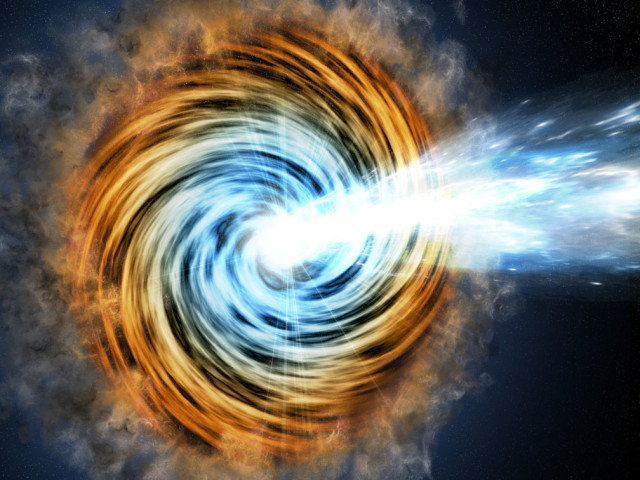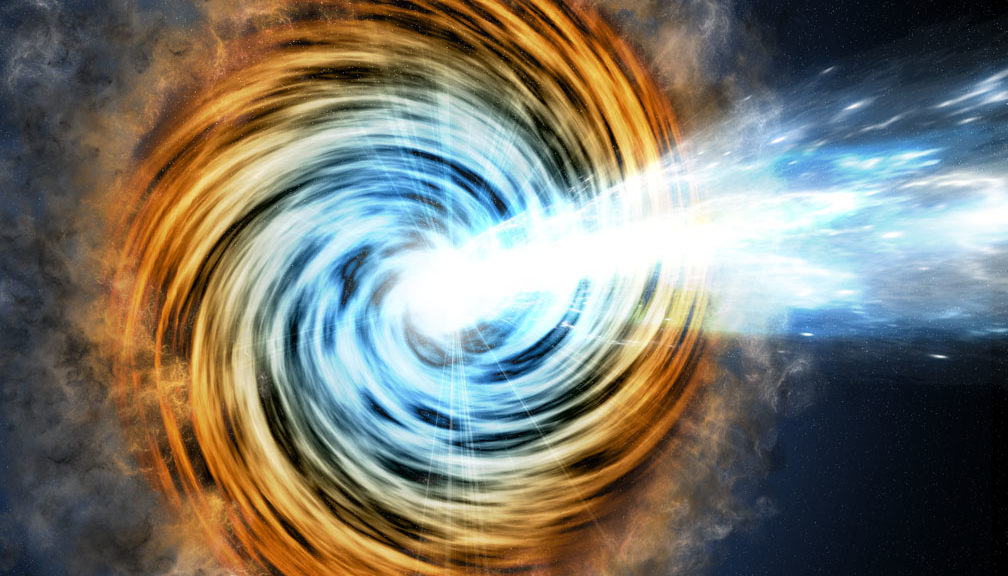
This artist’s conception shows a blazar – the core of an active galaxy powered by a supermassive black hole. (M. Weiss/CfA)
Back in April 2015, a surge of high-powered gamma rays from half-way across the universe crashed into Earth’s atmosphere.
But, according to the Harvard-Smithsonian Center for Astrophysics in Cambridge, Massachusetts, the burst of gamma rays didn’t put any of us in danger and produced no noticeable effects since the high-energy rays are blocked by Earth’s atmosphere.
Astronomers, using space and ground based telescopes found that this burst of powerful emissions came from a unique and active galaxy 7.6 billion light years from Earth.
The galaxy, known as PKS 1441+25, is actually a rare, compact and very bright mass of energy and light called a blazar.
The blazar’s twin powerful and opposite directed jets of plasma are driven at near light speed by a supermassive black hole located in the center of the galaxy.
As a black hole sucks in a variety of matter, such as dust, gas and even a star, it forms a surrounding high-energy accretion disk of elementary particles such as photons, electrons and positrons.
Friction is generated as these subatomic particles, from the accretion disk, gets pulled into the black hole’s point of no return (event horizon). The friction heats tiny bits of material into a plasma. The plasma combines with the black hole’s revolving magnetic field to form the blazar’s jets.
While scientists are still arguing over the exact processes that generate the gamma-ray emissions from the jets, the researchers say their findings will provide valuable clues.
April’s gamma ray burst was observed and studied over a number of different wavelengths with telescopes such as NASA’s Fermi Gamma Ray and Swift space telescopes and the Very Energetic Radiation Imaging Telescope Array System (VERITAS) in Arizona.
The astronomers said their multi-wavelength observations of this rare phenomena provided them with valuable insight into where such gamma rays are produced, the various physical processes that occur near the black hole, as well as a unique look into the distant galaxy.
The researchers figured that the region where the burst of gamma rays originated is probably about five light years from the black hole, which is much further than they expected.
They also found that the size of the gamma ray emitting region was around a third of a light year across, which was bigger than what is normally observed in an active galaxy.
The astronomer’s findings will be published in Astrophysical Journal Letters, which are currently available online.
NASA Goddard Video Explains Distant Blazar and Blast of Gamma Rays






















Comments are closed.